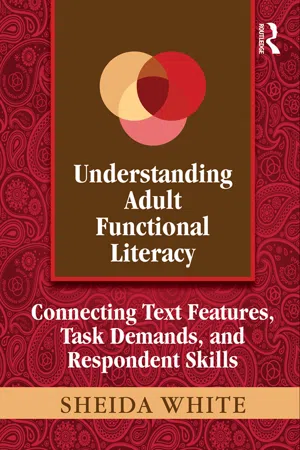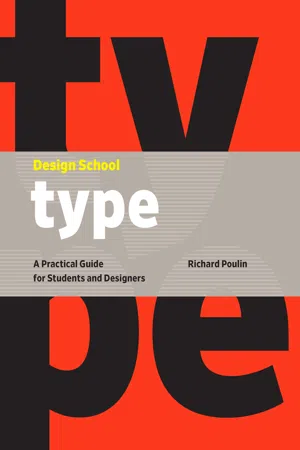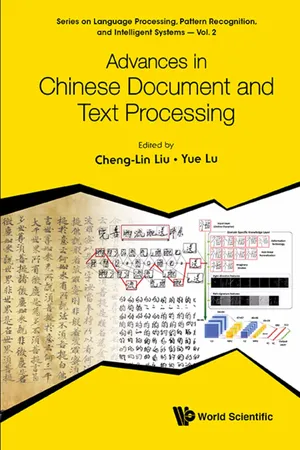Languages & Linguistics
Typographical Features
Typographical features refer to the visual aspects of written language, including font styles, sizes, and spacing. These features play a crucial role in conveying meaning, emphasis, and tone in written communication. Examples of typographical features include bold, italics, underlining, and different font families.
Written by Perlego with AI-assistance
3 Key excerpts on "Typographical Features"
- eBook - ePub
Understanding Adult Functional Literacy
Connecting Text Features, Task Demands, and Respondent Skills
- Sheida White(Author)
- 2010(Publication Date)
- Routledge(Publisher)
2Fourteen Text Features Related to Information Presentation
Presented below are 14 text features related to the presentation of information within the text:• Typographical devices • Organizational devices • Repetition of key terms • Presence of similar forms • Order of fact presentation • Specificity • Genre-specific cues • Discourse markers • Pronouns • Syntactic cues • Syntactic embedding and propositional density • Long sentences • Low-frequency words • Long, polysyllabic, and irregular wordsExhibit 4.3 illustrates several types of text features. The right side of the exhibit shows an actual task (including its associated text), and the left side lists relevant task facilitators and inhibitors.Typographical Devices
Key information in the text may be highlighted by typographical devices, such as capitalization (of all letters in one or more words), colored type (used for one or more words), font variation, dashes, a colon, italics, boldface, or underlining (of all letters in one or more words). Typographical devices draw attention to the characteristics or appearance of printed information. During task performance, typographical devices can act as facilitators or inhibitors: When typographical devices increase the salience of information required to answer the question, they can make it easier to find and interpret this information (Britton & Gulgoz, 1991). However, typographical devices also may divert attention from the preferred response and draw attention to a plausible but wrong answer if they are not relevant to the task at hand. - eBook - ePub
Design School: Type
A Practical Guide for Students and Designers
- Richard Poulin(Author)
- 2017(Publication Date)
- Rockport Publishers(Publisher)
Section 4
Typographic Principles
T ype in graphic design, like written and verbal communications, involves analysis, planning, organization, and ultimately problem-solving. When you write, or speak, you intuitively choose which words to use and how to use them together to effectively communicate your message. With type, the same end result can be achieved; however, a graphic designer needs to be as intuitive.MEASUREMENT: POINT MEASUREMENT: DIDOT MEASUREMENT: METRICTypographic principles are the fundamentals relied upon to use type in the most appropriate and effective manner in creating meaningful and understandable visual messages in graphic design. Type is one of the numerous elements, or the “what” of a graphic designer’s visual language, and principles are the “how.” When carefully considered and used together, they allow you to “speak” in an accessible, universal visual language.We are taught at an early age about the principles and elements of written and verbal communications. Unfortunately, the same cannot be said for graphic design. However, as we were taught the basics of spelling, grammar, and syntax, we can be taught the same basic fundamentals of graphic design, including the principles of type.Typographic principles such as measurement, tracking, kerning, word spacing, alignment, readability, legibility, emphasis, and hierarchy are all a graphic designer’s vocabulary and grammar for giving voice and, ultimately, meaning to type in any visual communication. Without a reliance on these principles, type will be ineffective, non-communicative, and will not “speak” to any audience. - eBook - ePub
- Cheng-Lin Liu, Yue Lu;;;(Authors)
- 2017(Publication Date)
- WSPC(Publisher)
Chapter 1
Characteristics of English, Chinese, and Arabic Typefaces
Ching Y. Suen, Shima Nikfal, Bing Zhang and Jehan Janbi
Centre for Pattern Recognition and Machine Intelligence ,
Concordia University, Montreal, Quebec H3G 1M8, Canada
[email protected]
This study attempts to identify the personalities associated with various fonts. We focused on the English typefaces and their personality traits. By conducting a font survey, 71 participants rated the 6 personality traits (Legible, Artistic, Formal, Sloppy, Readable, and Attractive) of 24 English typefaces using a modified five point Likert Scale. For the Chinese and Arabic fonts, we present their typographical characteristics against the English typefaces. Personalities associated with them are presented in tables and the characteristics of Chinese and Arabic typefaces are compared with the English counterparts.1.Introduction
Since the first reported study in 1920 by Berliner (as cited in Davis & Smith, 1933), the connotative role of typography has been a frequently-researched topic in business, psychology, design, and education. According to the psychologists, typography is defined as the “art of using typeface, layout, and color to convey the meaning of text” (Smart et al ., 2000), or as “the form, spacing, and layout of words and sentences in the text of a written or displayed communication message” (McCarthy & Mothersbaugh, 2002). In general, typography is the tool that creates words from characters for example 26 basic in English on paper or screen.Typefaces are usually classified according to overall appearance and unique Typographical Features which influence the nature of the typefaces and make them more suitable for some purposes such as (serif, sans serif, display, etc.) or proportionality of the typeface. The combination of appearance and Typographical Features guided typographers using personality traits to describe typefaces (“less cuddly, more assertive”, Berry, 2004). Typographers and designers are often interested in the typeface personality or “typographic allusion” which refers to “the capacity of a typestyle to connote meaning over and above the primary meaning which is linguistically conveyed by words” (Lewis & Walker, 1989).
Index pages curate the most relevant extracts from our library of academic textbooks. They’ve been created using an in-house natural language model (NLM), each adding context and meaning to key research topics.
Explore more topic indexes
Explore more topic indexes
1 of 6
Explore more topic indexes
1 of 4


